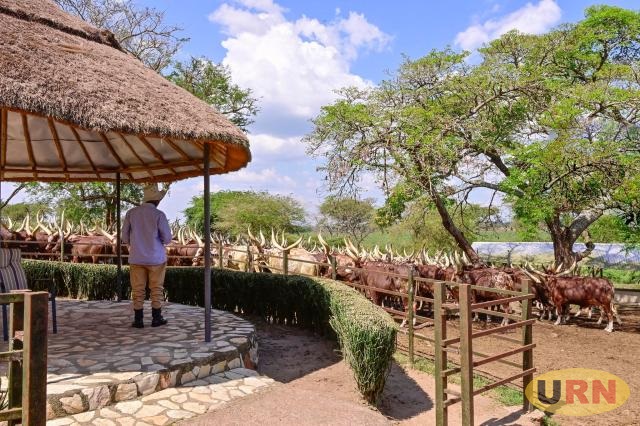
Mbarara, Uganda | THE INDEPENDENT | The existing livestock practices in Uganda’s cattle industry can be used to limit the emission of greenhouse gases.
This is part of the findings from the Support to Rural Sustainable Transformation (SIRGE) project, funded by the European Union.
The project aimed at providing more accurate data on the carbon emissions from the cattle industry. It also promoted innovative and climate-smart agricultural practices in Uganda.
The project has been implemented by Agency for Technical Cooperation and Development (ACTED) – a French charity with operations in 37 countries including Uganda.
The project in Uganda was implemented between 2021 and 2024 in the cattle corridor districts of Nakasongola and Mbarara.
Dr. Muhammad Kiggundu, a livestock nutrition expert with National Livestock Resources Research Institute (NaLIRRI) said the findings provide a wealth of data that can be used by farmers.
“The positive aspect is that we can take action, and it’s not rocket science; these are well-known practices, the best farm practices rotating around the breed of livestock, feeds, and manure management among others,” he said.
Dr Kiggundu said that implementing best farm practices is the solution as it can enhance livestock performance and efficiency and curb on-farm emissions. One such practice, he suggested, is exploring appropriate feeding strategies that increase productivity while at the same time reducing methane emissions from enteric fermentations.
“The amount methane produced by the animal is related to the quality of feed consumed. In Uganda, most cattle graze on natural tropical pastures on the range which are low in crude proteins and high in fiber,” Kiggundu explained.
Some studies have reported varying ranges of atmospheric concentrations of methane gas among the Ankole, Nganda, and Zebu cattle breeds.
Previously, there has been fear that livestock farms are emitting large atmospheric concentrations of methane from cow dung or animal droppings. Emissions from cattle’s intestine gas, belching and the breakdown of their manure further aggravate the methane concentration.
Some experts have suggested that farmers need to reduce the number of cows in their holdings as part of the concerns about emissions and global warming. Kiggundu advises that farmers need to feed the livestock on improved forages and use conserved feeds like Hay, Silage, and Seed supplements.
John Begumana Ayengyera, a climate change consultant and one of those who carried out the study, encouraged farmers to adopt methods like composting and utilizing manure to capture and use methane for biogas production.
“Converting methane into gas is beneficial, as farmers can also earn from it through the carbon credit,” said Ayengyera.
Jones Ruhombe, a farmer from Kiruhura District, expressed reservations about biogas. He told URN that many farmers have attempted it but failed due to availability of substandard equipment and short-lived biogas digesters..
Ruhombe also acknowledged that farmers can play an effective role in the fight to reduce on-farm emissions, as the recommended best practices are often familiar to them. However, he added that more studies are needed to provide specific results regarding the relationship between breeds, grazing pastures, and feeds with emissions.
Denis Mulongo Maholo, Acting Commissioner in the Ministry of Agriculture, Animal Industry, and Fisheries, emphasized that farmers should not expect anything new or a magic bullet for controlling or reducing emissions but should focus on improving their farming practices as recommended.
Mulongo added that having a large number of livestock that produce less while emitting a significant amount of greenhouse gases is not beneficial. Finding a way to increase productivity while addressing emissions would be the best approach for farmers.
Dr. Joseph Kagoro Ruhinda, an Animal Health Scientist and program manager at Uganda Meat Producers Cooperative Union Ltd, emphasized that although the larger issue of climate change is primarily caused by emissions from global north countries, this should not hinder countries like Uganda from intensifying efforts to mitigate and adapt.
Dr. Ruhinda commends the initiatives to generate local information, data, and research on climate change and its impact on livestock. He said Uganda now has an opportunity to assess its position about methane emission from the livestock sector. Ruhinda is of the view that by using these already-known practices Uganda can continue growing its cattle sector without fear of harming the planet.
According to a 2019 Food and Agriculture Organisation – FAO report, Uganda’s livestock sector, encompassing dairy and beef production, plays a pivotal role in the nation’s economy. It provides sustenance, income, and livelihoods for approximately 3.9 million households, constituting around 58 percent of the population.
The sector also makes a substantial contribution to agricultural exports. In the 2020/21 fiscal year, it contributed 6,456 billion shillings to the economy, with exports reaching USD 23.214 million.
********
URN



